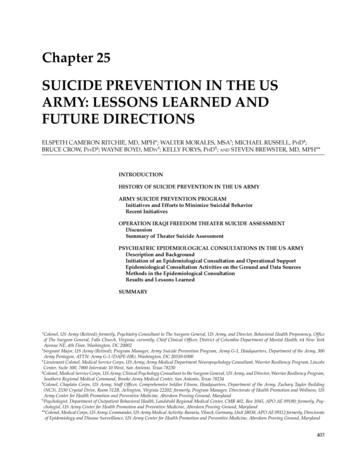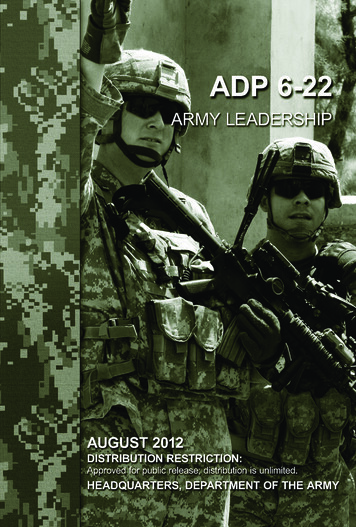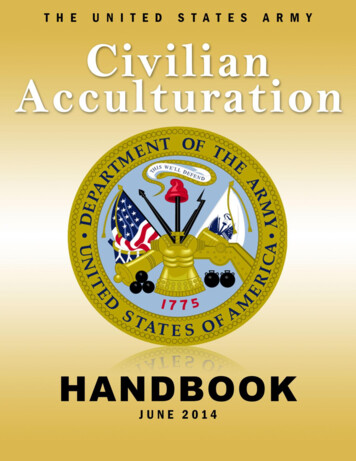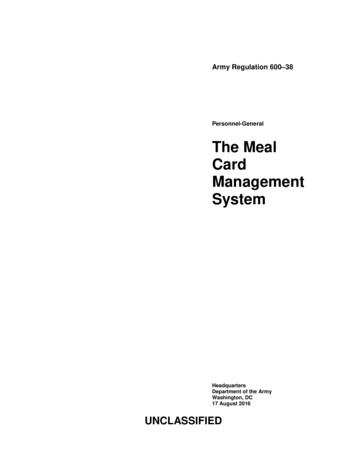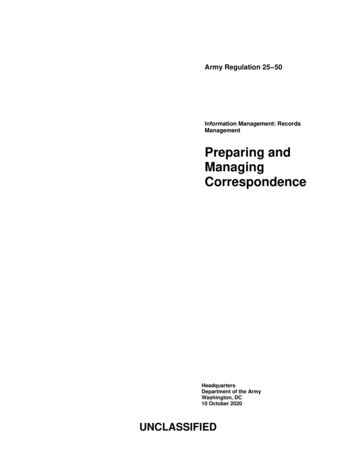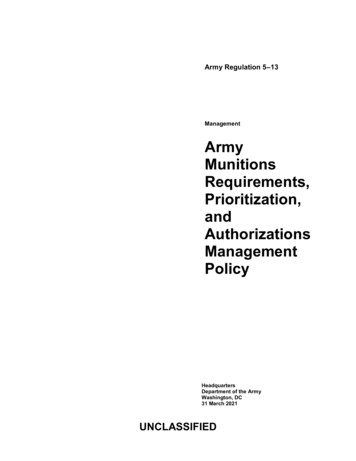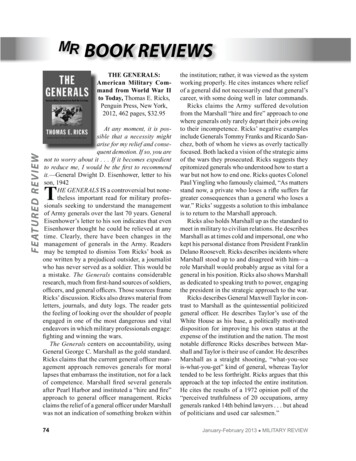
Transcription
MRBOOK REVIEWSF E AT U R E D R E V I E WTHE GENERALS:AAmerican Military Command from World War IImto Today, Thomas E. Ricks,Penguin Press, New York,2012, 462 pages, 32.95At any moment, it is posssible that a necessity mightaarise for my relief and conseqquent demotion. If so, you arenot to worry about it . . . If it becomes expedientto reduce me, I would be the first to recommendit.—General Dwight D. Eisenhower, letter to hisson, 1942HE GENERALS IS a controversial but nonetheless important read for military professionals seeking to understand the managementof Army generals over the last 70 years. GeneralEisenhower’s letter to his son indicates that evenEisenhower thought he could be relieved at anytime. Clearly, there have been changes in themanagement of generals in the Army. Readersmay be tempted to dismiss Tom Ricks’ book asone written by a prejudiced outsider, a journalistwho has never served as a soldier. This would bea mistake. The Generals contains considerableresearch, much from first-hand sources of soldiers,officers, and general officers. Those sources frameRicks’ discussion. Ricks also draws material fromletters, journals, and duty logs. The reader getsthe feeling of looking over the shoulder of peopleengaged in one of the most dangerous and vitalendeavors in which military professionals engage:fighting and winning the wars.The Generals centers on accountability, usingGeneral George C. Marshall as the gold standard.Ricks claims that the current general officer management approach removes generals for morallapses that embarrass the institution, not for a lackof competence. Marshall fired several generalsafter Pearl Harbor and instituted a “hire and fire”approach to general officer management. Ricksclaims the relief of a general officer under Marshallwas not an indication of something broken withinT74the institution; rather, it was viewed as the systemworking properly. He cites instances where reliefof a general did not necessarily end that general’scareer, with some doing well in later commands.Ricks claims the Army suffered devolutionfrom the Marshall “hire and fire” approach to onewhere generals only rarely depart their jobs owingto their incompetence. Ricks’ negative examplesinclude Generals Tommy Franks and Ricardo Sanchez, both of whom he views as overly tacticallyfocused. Both lacked a vision of the strategic aimsof the wars they prosecuted. Ricks suggests theyepitomized generals who understood how to start awar but not how to end one. Ricks quotes ColonelPaul Yingling who famously claimed, “As mattersstand now, a private who loses a rifle suffers fargreater consequences than a general who loses awar.” Ricks’ suggests a solution to this imbalanceis to return to the Marshall approach.Ricks also holds Marshall up as the standard tomeet in military to civilian relations. He describesMarshall as at times cold and impersonal, one whokept his personal distance from President FranklinDelano Roosevelt. Ricks describes incidents whereMarshall stood up to and disagreed with him—arole Marshall would probably argue as vital for ageneral in his position. Ricks also shows Marshallas dedicated to speaking truth to power, engagingthe president in the strategic approach to the war.Ricks describes General Maxwell Taylor in contrast to Marshall as the quintessential politicizedgeneral officer. He describes Taylor’s use of theWhite House as his base, a politically motivateddisposition for improving his own status at theexpense of the institution and the nation. The mostnotable difference Ricks describes between Marshall and Taylor is their use of candor. He describesMarshall as a straight shooting, “what-you-seeis-what-you-get” kind of general, whereas Taylortended to be less forthright. Ricks argues that thisapproach at the top infected the entire institution.He cites the results of a 1972 opinion poll of the“perceived truthfulness of 20 occupations, armygenerals ranked 14th behind lawyers . . . but aheadof politicians and used car salesmen.”January-February 2013 MILITARY REVIEW
BOOK REVIEWSRicks argues for a return to Marshall’s style asa professional, that of candid discourse betweengenerals and their civilian leaders. This is so,Ricks’ says, because wars waged by a democracymust be executed through a dynamic collaborationbetween military and civilian leaders.The last chapter of The Generals is among themost compelling. Here, Ricks makes his case forhow to proceed. Military professionals shouldengage in a meaningful dialogue. Some recommended discussion questions: Is it true that thegeneral officer corps needs more accountabilityand if so, is firing generals an effective way tomanage them and improve accountability? Howcan we better groom officers (potential generals)to lead us through the challenges of an uncertainfuture? What are officer promotions based on,performance or potential? If potential, how shouldpotential be measured and by whom?Both civilian and military DOD personnelshould read the book. Some readers may findRicks’ premises questionable and his conclusionsunsatisfying. However, rather than avoiding acontroversial discussion, the Army and the restof the Department of Defense should face thisdiscourse head-on and use it to improve itself.Even if some think he fails to diagnose the disease, the symptoms he describes are undeniable,as evinced yet again in the recent series of seniorofficer meltdowns. The Generals is an excellentsource for leader development programs.F E AT U R E D R E V I E WLTC Richard A. McConnell, USA, Retired,Fort Leavenworth, KansasJOE ROCHEFORT’S WAR:The Odyssey of the Code Breaker WhoOutwitted Yamamato at Midway,Elliott Carlson,USNI Press, Annapolis, MD,2011, 616 pages, 36.95ON 2 DECEMBER 1941, Admiral HusbandE. Kimmel joked to Lieutenant CommanderEdwin T. Layton, “What, you don’t know wherethe carriers are? Do you mean to say they could berounding Diamond Head and you wouldn’t know it?”Layton replied that he hoped they would be sightedbefore then. In fact, the Japanese strike force wasactually steaming northwest of Oahu en route to itsrendezvous with destiny.January-February 2013 MILITARY REVIEWPearl Harbor is an American disaster that hasattained iconic status. “Remember the Alamo,”“Remember the Maine,” and “Remember PearlHarbor” all have this stature. There is a tragic sensethat Pearl Harbor could have been avoided in thesame way it seems unreal the Titanic sank on hermaiden voyage.What matters about Pearl Harbor is not whatmight have been but what we have yet to learn fromthe sad events of that Sunday more than 70 yearsago. Understanding what enabled a surprise attackilluminates aspects of American decision making thatseem to be enduring, but need not be.Joe Rochefort’s War is an essential addition to thelibrary of any military professional who wants tolearn the nature of signals intelligence from soup tonuts, including traffic analysis, which was particularly useful during the war. Commander Rochefortand his team later enabled the U.S. Navy to ambushthe Imperial Japanese Navy at Midway and defeatthem decisively. But in 1941, Joe Rochefort got itwrong. He came close to getting it right, but in theend, his analysis and equally important his assumptions led him to estimate the Japanese would attack,but not at Pearl Harbor. Rochefort was not alone inthis assumption. U.S. decision makers widely sharedthis belief; it was an article of faith.Roberta Wohlstetter’s Pearl Harbor: Warning andDecision is arguably the standard for understandingjust how Japan managed to surprise the United Statesthat December morning. Wohlstetter’s examinationof the decision-making apparatus in the United Statesthat enabled good people to reach catastrophicallywrong conclusions is, in a word, brilliant.Decision makers often demonstrate an almostterminal capacity to ignore evidence that does notmeet their expectations. Mistakes similar to thosemade before Pearl Harbor occurred in the run up to9/11 during Operations Iraqi Freedom and EnduringFreedom. Bureaucratic organization and competition often preclude unity of effort, let alone unity ofcommand. Cohesion among decision makers limitstheir ability to examine alternatives or challengeassumptions. Excessive background noise inhibits their capacity to interpret the data accurately.Other important books about Pearl Harbor includeAlan D. Zimm’s Attack on Pearl Harbor: Strategy,Myths, Deceptions; Thomas B. Steely, Jr.’s, PearlHarbor Countdown: Admiral James O. Richard75
BOOK REVIEWSson; and George Victor’s The Pearl Harbor Myth:Rethinking the Unthinkable. Japanese sourcesinclude Hiroyuki Agawa’s The Reluctant Admiral:Yamamoto and the Imperial Navy (translated byJohn Bester); Admiral Matome Ugaki’s FadingVictory: The Diary of Admiral Matome Ugaki,1941-1945 (translated by Masataka Chihaya); andGod’s Samurai: Lead Pilot at Pearl Harbor byGordon W. Prange with Donald M. Goldstein andKatherine V. Dillon.What emerges from these books deepens andenriches Wohlstetter’s effort. Each book has something to say that deserves hearing. Zimm’s analysisof the attack on Pearl Harbor focuses on a systemsanalysis approach to the problem largely from theperspective of the Japanese. He illuminates Japanese motives, their preparation, and most importanttheir objectives for the attack. In doing so, he largelydebunks the commonly held view of Japanese brilliance. The myth, according to Zimm, is that visionary Japanese officers, including Yamamoto, Genda,and Fuchida, managed to conceive and executewith genius in the face of recalcitrant admirals. YetYamamoto’s attack aimed not at the carriers but atthe battleships. Yamamoto, too, appears to haveconcluded that sinking battleships would precludeeffective action by the remainder of the U.S. Pacificfleet. Zimm is convincing on a number of countsincluding how big a risk the Japanese perceived theywere taking. Why then did they succeed?What seems least likely is the explanation offeredin Victor’s The Pearl Harbor Myth. Victor raisesa number of excellent questions that challengethe “official” story of the events leading to PearlHarbor, but in the end, he suggests Pearl Harborhappened because President Roosevelt and hissenior leaders used the Pacific Fleet to tantalizethe Japanese into attacking. While the idea is plausible—given the way governments work—as anexplanation for Pearl Harbor, it requires a level ofcynical competence that seems unlikely at best. Amore likely explanation for Roosevelt’s decisionto leave the fleet in Hawaiian waters followingFleet Problem XXI in the spring of 1940 is that hegenuinely thought the presence of the battle fleetin Hawaii would deter the Japanese.James O. Richardson, the admiral who precededHusband E. Kimmel in command of the fleet, didnot agree. In Pearl Harbor Countdown, he focuses76on the considerable resource problems that emergedwith the fleet crammed into Pearl Harbor, which wastoo small and too hard to get in and out of and lackedsufficient means to overhaul vessels. Pearl Harbors’limitations were such that Richardson kept the fleetat sea or in anchorages nearby when he could. Helobbied against the decision to leave the fleet inHawaiian waters until the president relieved him.Reading the Japanese sources is important, too.Wohlstetterr did not have them at hand when shestudied the problem. Like their American opponents,Yamamoto, Ugaki, and Fuchida often made faithbased decisions. In October 1941, Ugaki confidedin his diary, “Our capacity to produce planes andreplenish air crews are two causes of anxiety.” Butin the next sentence, like Stonewall Jackson, hedetermined not to take counsel of his fears. Fuchidaquoted Admiral Nagumo, the striking force commander, “When men work as hard as we have onthis operation, providence will favor them with itsblessing.” Yamamoto’s reservations about going towar with the United States are well known. Less wellknown is that in September 1941 he said, “The PearlHarbor raid has become an article of faith.” Clearly,Yamamoto, the poker player and cold-blooded rationalist, had his convictions. Humans, whether Japanese or American, find it difficult to accept evidenceof things they do not believe. Here ends the lesson.COL Greg Fontenot, USA, Retired,Fort Leavenworth, KansasFROM A to B: How Logistics FuelsAmerican Power and Prosperity,David Axe, Potomac Books, Inc.,Quicksilver, VA, 2011, 224 pages, 24.50An army marches on its stomach.—NapoleonBonaparteAmateurs talk about strategy. Professionals talkabout logistics.—Omar N. BradleyLogistics has become the key to American powerand prosperity.—David AxeFTER READING REPORTER David Axe’smissives on war and technology for years, Ihad no doubt his book, From A to B, would accurately depict logistics from an “on-the-ground” perspective and incorporate the latest in technologicaladvances. He did not disappoint.AJanuary-February 2013 MILITARY REVIEW
BOOK REVIEWSFrom A to B is a great survey of the importanceof logistics to our military and our globalizedeconomy. Axe examines all possible modes totransport men and materiel around the globe—fromcars and trucks to ships and airplanes to zeppelinsand space planes.The book begins by establishing the importanceof logistics to our military operations and makes itclear that it is dirty, dangerous work that is probably the most complex aspect of military planning.He provides as an example the logistical surge ofmine-resistant, ambush-protected (MRAP) trucksinto Iraq and Afghanistan to protect Americantroops. Axe discusses an alternate solution to theexpensive MRAPs—robotically controlled logistical transport. Consider the merging of today’scommercial trucks with the technological powerof unmanned aerial vehicles. These vehicles coulddecrease the need for manned vehicles on dangerous roads and provide more time and attention tomanned security vehicles.Axe’s section on our “most capacious and underappreciated logistical system: her naval ships” isamazing. The depiction of how difficult, yet crucial,at-sea refueling is to power projection throughoutthe world provided me a much greater appreciationof how the United States is unlike any other navyin the history of the world.When Axe moves to airlift, it is obvious hisexample would be Afghanistan. He has coveredthis subject extensively in his reporting. Anyonepaying attention to the war will understand the sheermagnitude of logistically supplying the country, aswell as transporting troops throughout this diverseand hazardous geographic area. Axe does a greatjob of describing the criticality of robust logisticallift capabilities like the CH-47 Chinook.Finally, Axe delves into two future capabilitiesfor logistics—airships and space planes. The factthat modern airship technology could transport anentire battalion 4,000 miles, at 100 miles per hour,at 60 percent the cost of an airplane was astounding.While he does discuss the difficulty airships have inadverse weather, he does not address how airshipscould overcome the adverse conditions war alwaysbrings (such as antiair defenses). His discussion of aspace plane that could carry materiel, and possiblypersonnel, anywhere in the world in two hours wasintriguing.January-February 2013 MILITARY REVIEWFrom A to B is an engaging look at the diverseinfluences future technologies will have on our ability to move and supply our troops and our economy.Axe continues to entertain and inform—and hisclosing comment is a clarion call: “World-beatinglogistics requires investment on a national scale.That kind of investment requires political will.”CPT Nathan Finney, USA,Belmont, MassachusettsTHE SCHOOL OF HARD KNOCKS:Combat Leadership in the AmericanExpeditionary ForcesRichard S. Faulkner,Texas A&M University Press, College Station,2012, 392 pages, 65.00RICHARD S. FAULKNER has rightly namedhis book The School of Hard Knocks. Thecombat leadership in the American ExpeditionaryForces (AEF) did in fact learn the lessons of war thehard way, often at the expense of soldiers’ lives. Ourhistory, leadership, and tactics books convenientlyignored the faults of the AEF’s combat leadershipfor years. After all, the war, a short one, at that,was won in part because of America’s involvement.Some recent books on AEF leadership failures,such as Robert Ferrell’s 2004 Collapse at MeuseArgonne: The Failure of the Missouri-KansasDivision, are about specific units, as if they were ananomaly, but Faulkner exposes how widespread theunpreparedness of our combat leadership actuallywas. There were indeed many hard lessons learnedin World War I, as NCO and commissioned officerselection and training set the conditions for leadership challenges on the battlefield.Faulkner guides the reader from officer trainingjust before the war, during the vast buildup, and inFrance, where the hard knocks would fall. He alsoaddresses the junior officer “ninety-day wonders”and ad-hoc methods of selecting NCOs, or “jumpedup sergeants.” The relationships between the leadersand the led, including those of supposedly experienced allied army trainers, are revealing.Faulkner has invested years of research toproduce this insightful and entertaining book. Hecombines factual information with real-life occurrences. Sending young and fully prepared NCOs77
BOOK REVIEWSand officers to lead units in combat after theirinitial training is a daunting task. World War I wasan example of the price this country paid in bloodbecause of an inadequately trained NCO and officer corps. Faulkner makes the point that the youngofficers and NCOs were patriotic, educated, dedicated, and brave, and did the best they could underthe conditions they faced. Most of their difficultieswere due to systemic problems associated withAmerica’s lack of preparedness to fight a modern,extremely lethal war. Perhaps just as critical wasthe Army’s willingness to accept quantity over quality during the massive build up of the AEF, in thebelief that maintaining a small army is preferableduring peacetime because “we can always rampup” during times of war.LTC Scott A. Porter, USA, Retired,Fort Leavenworth, KansasVICTORY FOR HIRE: Private SecurityCompanies’ Impact on Military EffectivenessMolly Dunigan, Stanford Security Studies,Stanford University Press, Stanford, CA,2011, 235 pages, 24.95involving force extenders are not new. Mercenarieshave served nearly every army from ancient Egyptto the present. However, the repeated controversiesabout force extenders have not stopped their use.How can we best use private security contractors? Should they deploy with the U.S. military,work independently, or replace part of the military’sfighting forces? What problems and benefits comefrom each role? Can hiring private security contractors sometimes hurt the military’s effectiveness sobadly that the contractors should not even be used?These are the issues Molly Dunigan analyzes inVictory for Hire.Dunigan uses past examples to illustrate whenand how contractors have succeeded or failed. Herexamples, analysis, and conclusions will be valuablefor military leaders who work with security contractors, to citizens concerned about security contractoruse, and to policy makers who decide whether to usethem. Dunigan concludes with specific recommendations for policy and regulatory changes.MAJ Herman Reinhold, USAF, Retired,Athens, New YorkCARTEL: The Coming Invasion ofMexico’s Drug WarsSylvia Longmire,Palgrave Macmillan, New York,2011, 256 pages, 26.00THE UNITED STATES used more privatesecurity contractors in Afghanistan and Iraqthan deployed military. Kellogg, Brown, and Root(KBR) sold logistical services to the United Statesin Kosovo, Iraq, Afghanistan, and Guantanamo Bay,and Blackwater sold diplomatic security services inIraq. Victory for Hire looks at how private securitycontractors affect military effectiveness.The use of private security contractors as “forceextenders” has grown recently, as have the scandalsin which the contractors became involved. DynCorpemployees were involved in Bosnian child prostitution, the murder of an Iraqi taxi driver, and wastedmillions of dollars in Iraq. Over 380 KBR employees were wounded and about 80 were killed in Iraq,Kuwait, and Afghanistan. KBR’s president wentto jail for bribing Nigerians, and KBR paid 570million in fines and settlements in related cases.Blackwater staff murdered Iraqis, and senior boardmembers illegally possessed automatic weapons inthe United States. Citizens and politicians questionthe legality, value, and morality of using contractorsinstead of military members in war zones. Scandals78EXPERIENCED BORDER SECURITY expertSylvia Longmire’s Cartel: The Coming Invasion of Mexico’s Drugs Wars addresses the Mexicancartels’ origins, sketches their operations withinMexico, and tackles their security implications forthe United States and Mexico.She outlines how the Guadalajara Cartel led byMiguel Ángel Félix Gallardo aka El Padrino (TheGodfather) flourished in the 1980s. Regarded asMexico’s first drug czar and cartel lord to control allillegal narcotics trafficking in Mexico and associatedcorridors or plazas into the United States, Gallardodivided Mexico’s trafficking corridors during thelate 1980s, and created a group of trusted protégés tomanage them. Three of these protégés remain today,operating the Sinaloa, Juárez, and Tijuana Cartels.Longmire identifies kidnapping as the secondbiggest cartel moneymaker. However, she fails toJanuary-February 2013 MILITARY REVIEW
BOOK REVIEWSaddress other illicit cartel ventures such as counterfeit product sales (CDs, DVDs, and apparel), humantrafficking, prostitution, and money laundering. Sherecognizes that the cartels are the “biggest armedforce south of the border” and use increasinglyeffective and powerful weapons. However, she doesnot discuss their use of more advanced weaponssystems such as the rocket-propelled grenade.The author defines these organizations as ahybrid threat, a combination of terrorists, insurgents, and criminals and discusses how the UnitedStates and Mexico (and their subordinate agencies) are failing when it comes to law and policy.Unfortunately, she misidentifies not only the groupsthemselves, but terms such as “spillover violence.”She observes that adding the concept of “winning”into the equation muddies the waters and makes iteven harder for agencies to secure funding.Longmire offers practical solutions to many ofthe critical problems addressed in her monograph.Cartel is a necessary read for those wanting acomprehensive look into the decade’s-old drug waraffecting the United States and Mexico.Tony Scheidel, Fort Leavenworth, KansasTHE NEW LEGIONS: American Strategy andThe Responsibility of PowerEdward B. Atkeson, Rowman andLittlefield Publishers Inc., Lanham, MD,2011, 211 pages, 35.00RETIRED U.S. ARMY major general andsenior fellow at the Institute of Land Warfare,Association of the U.S. Army, Edward Atkesonhas written an interesting book recommendingan unusual strategy to foster American strategicinterests around the world. His thesis is that theUnited States could effectively use a U.S.-led foreign legion to extend its global reach as the world’ssheriff. The legionnaires would be motivated by theoffer of U.S. citizenship after a number of years ofservice. He proposes paying the legionnaires lessthan the United States pays its active duty forcesto avoid their being confused as mercenaries. Theforeign legion soldiers would presumably be bettertrained and led than host nation police or militaryunits and more readily accepted. Atkeson’s preferred example is the French Foreign Legion.January-February 2013 MILITARY REVIEWAtkeson first details the evolution of currentinternational events that have been shaped by policies and decisions focused on Iraq and Afghanistan.He prefers to quote extensively from other nationalsecurity observers and newspapers includingAnthony Cordesman, Fareed Zakaria, Max Boot,the Washington Post, and the New York Times. Hisanalysis provides nothing new to the discussion, butthe summary is a spirited review of events.In the second part of the book, Atkeson uses Dr.Thomas Barnett’s approach to analyze regionaldysfunctions that are similar to Barnett’s “nonintegrating gap.” While these country and regionalexcursions are informative, they do not enhancethe argument for a foreign legion as a tool of U.S.policy. The chapters on Latin America, Cuba,Africa, and Asia provide details on the currentpolitical-military situation, but the reader gainslittle insight as to how the United States might usea legion there or if the host nation would support it.Well written and footnoted, the book could beuseful for scholars conducting research on thissubject. The book’s biggest shortcoming is itsinadequate discussion of the legality, perception,and potential use of American foreign legions. Thebook’s regional and country assessments are useful,but the author never uses the analysis effectively tofurther his case for a legion, nor does he questionhis assumption that U.S. domestic and internationalpublic opinion would support the legions.LTC Stephen G. Whitworth, USA, Retired,Fort Leavenworth, KansasLEADING THE NARRATIVE:The Case for Strategic CommunicationMari K. Eder, Naval Institute Press,Annapolis, MD, 2011, 126 pages, 24.95.IF YOU ARE a public affairs officer (PAO), information operations officer, a commander at battalion andhigher, or a professional communicator, Leading theNarrative is worth the time to read and refer to often.Mari K. Eder, a communication professional withinthe Army and the Department of Defense, examinesvarious forms of communication to demonstrate howto use strategic communication and lead the narrative.Eder skillfully explains all this via quotes andpast communication events, lessons learned, and79
BOOK REVIEWSadvice from communications field operators in themedia, military, and civilian sectors. One such pieceof advice comes from journalist Richard Halloran,who counsels that the most important element in therelationship between the PAO and the journalist isthe commander’s intent. The commander who hasan open or transparent communications attitude andfosters a similar command climate will enable thePAO and his subordinates to do their jobs. A commander who wants a “palace guard” to avoid theissues and avoid communication will get “bad” pressand provide inaccurate information to the public.Eder’s discussion of strategic communication,an often ill-defined, overused expression that fewunderstand and fewer know how to implement, isthe best I have seen to date. She discusses the uses ofnew technology, social media, and trends in publicopinion and weaves together a mosaic for both theprofessional and the layperson to grasp.Afghanistan and Pakistan is a Western inventionhaving little to do with the reality of the region andthe lives of its populace. Yet a lasting solution tothe Afghanistan conflict depends on the resolutionof its border with Pakistan. Second, the book isabout contemporary politics and U.S. influence onthose politics. Americans understand little aboutAfghanistan yet deliberately exert their influencewithout sufficient regard for its culture, history,and geography. Third, Pakistan is a regional powerin Southwest and Central Asia and a key Islamiccountry. The book’s emphasis is on presidentialstrategic communications, not military informationoperations. However, some of the best U.S. contactswith Pakistan are military-to-military, and the U.S.military needs to learn more about a troubled andsometimes troublesome region.Lester W. Grau, Ph.D., LTC, USA, Retired,Fort Leavenworth, KansasCOL Steve Boylan, USA, Retired,Fort Leavenworth, KansasTHE PAKISTAN CAULDRON:Conspiracy, Assassination & InstabilityJames P. Farwell, Potomac Books,Washington, DC, 2011, 304 pages, 29.95THE PAKISTAN CAULDRON revolves aroundBenazir Bhutto’s rise, her assassination, andthe actions and reactions of the Musharaf administration in dealing with her. Pakistan’s politics aretough to comprehend until one understands the roleof the military (the corps commanders), the ethnicand class divides of the society, and the cultures ofthose divides and how they influence governmentand politics. Throw in relations with neighborsand allies, the Sunni-Shi’a split, the long history ofgovernment noninterference in the Western frontierregions, and the plunging economy, and the readerfaces a very complex array. All of these factors areapparent to the author, although not to the averagereader, who needs a better introduction to Pakistanand its environs. Once author James P. Farwell hitshis stride, the book travels a smoother road and turnsinto a textbook on “strategic communications.”The military professional should read this bookfor three reasons. First, it is about a vital regionthat borders on Afghanistan. The border between80ARC OF EMPIRE: America’s Warsin Asia from the Philippines to VietnamMichael H. Hunt and Steven I. Levine,University of North Carolina Press, Chapel Hill,2012, 352 pages, 35.00THE ASIA-PACIFIC REGION has capturedsignificant attention in the last year. Eventsin the Middle East and Central Asia continue tovex U.S. foreign policy and military efforts, butthey are increasingly becoming a landscape in therear-view mirror as more emphasis on the greaterPacific region moves to center stage. Arc of Empire:America’s Wars in Asia from the Philippines to Vietnam provides insight into this complicated region.Authors Michael H. Hunt and Steven I. Levineoffer a thought-provoking study of the four U.S.wars in the Pacific.Hunt and Levine contend that the war with thePhilippines, the war with Japan, the Korean War,and the Vietnam War were not separate and unconnected, but “phases in a U.S. attempt to establishand maintain a dominant position in eastern Asiasustained over some seven decades against considerable resistance.” Recognizing the provocative nature of this thesis, the authors devote theirintroduction to explaining how they use the term“empire.” They provide an objective, his
Harbor, but in the end, he suggests Pearl Harbor happened because President Roosevelt and his senior leaders used the Pacific Fleet to tantalize the Japanese into attacking. While the idea is plau-sible—given the way governments work—as an explanation for Pearl Harbor, it requires a level of cynical competence that seems unlikely at best. A




